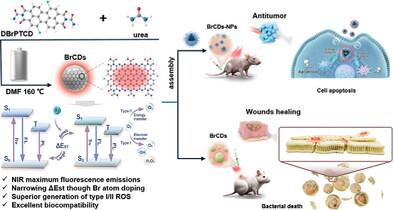Near-infrared Emission Carbon Dots Derived from Bromo-Substituted Perylene Derivatives with Simultaneously High Type I/II ROS Generation for Effective Bacterial Elimination and Tumor Ablation
IF 13
2区 材料科学
Q1 CHEMISTRY, MULTIDISCIPLINARY
引用次数: 0
Abstract
Bacterial infections and tumor tissues are characterized by complex microenvironments with uneven oxygen availability. Effective photodynamic therapy for these conditions requires photosensitizers that can perform optimally within such environments, specifically by generating both type I and II reactive oxygen species (ROS) simultaneously. Carbon dots (CDs), a type of fluorescent nanomaterial smaller than 10 nm, are commonly used to treat bacterial infections and tumors. However, their current limitations, such as short maximum absorption and emission wavelengths, significantly restrict their therapeutic efficacy in deep tissues. In response to these challenges, a new type of fluorescent carbon dots with near-infrared (NIR) absorption and emission properties is reported, featuring a maximum emission peak beyond 700 nm (NIR-I region). These CDs offer strong tissue penetration and reduced tissue absorption advantages. Additionally, bromine atom doping significantly enhances the generation of type I and II ROS through efficient photodynamic processes. In vitro studies demonstrated their high photodynamic efficacy in antibacterial and antitumor applications. Ultimately, these findings translate into significant therapeutic effectiveness for treating skin infections and tumors in vivo. This study employs bromine-doped CDs nanomaterials, which demonstrate maximum fluorescence emission in the NIR region, to achieve efficient photodynamic treatment of bacterial infections and tumor ablation in complex microenvironments.

求助全文
约1分钟内获得全文
求助全文
来源期刊

Small
工程技术-材料科学:综合
CiteScore
17.70
自引率
3.80%
发文量
1830
审稿时长
2.1 months
期刊介绍:
Small serves as an exceptional platform for both experimental and theoretical studies in fundamental and applied interdisciplinary research at the nano- and microscale. The journal offers a compelling mix of peer-reviewed Research Articles, Reviews, Perspectives, and Comments.
With a remarkable 2022 Journal Impact Factor of 13.3 (Journal Citation Reports from Clarivate Analytics, 2023), Small remains among the top multidisciplinary journals, covering a wide range of topics at the interface of materials science, chemistry, physics, engineering, medicine, and biology.
Small's readership includes biochemists, biologists, biomedical scientists, chemists, engineers, information technologists, materials scientists, physicists, and theoreticians alike.
 求助内容:
求助内容: 应助结果提醒方式:
应助结果提醒方式:


